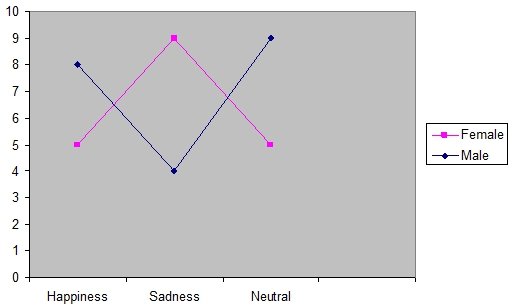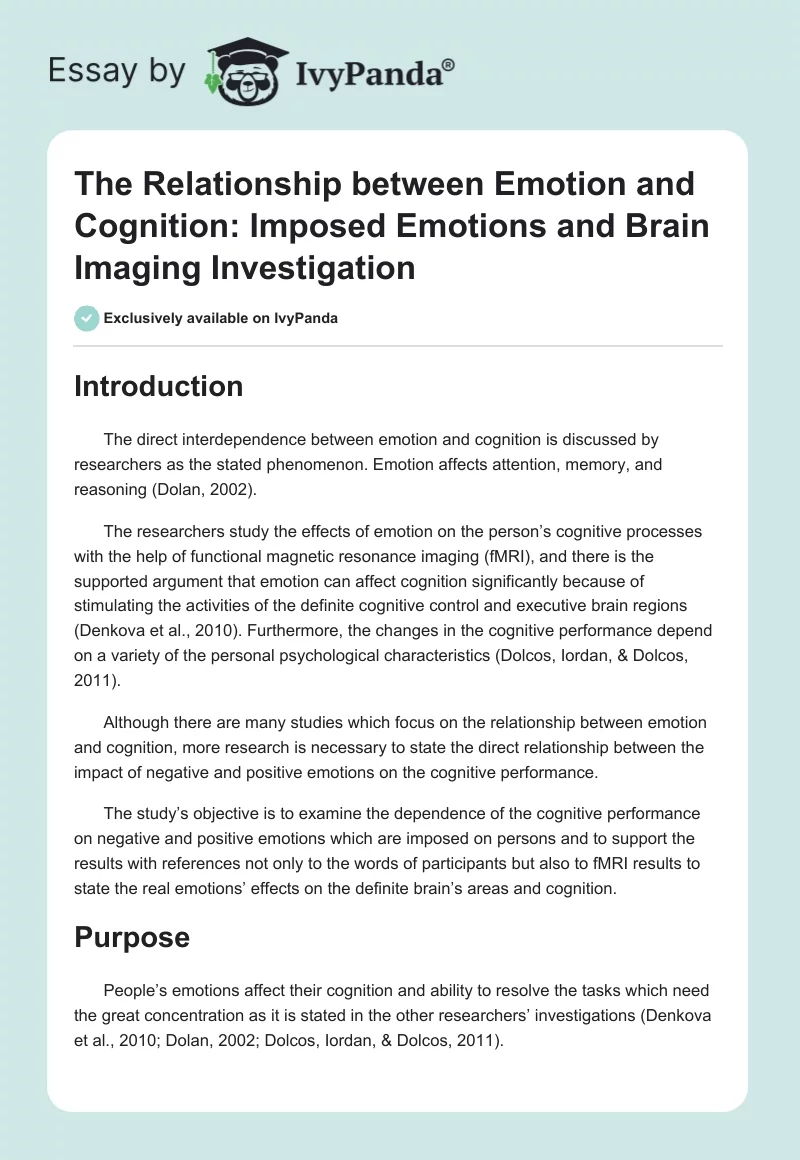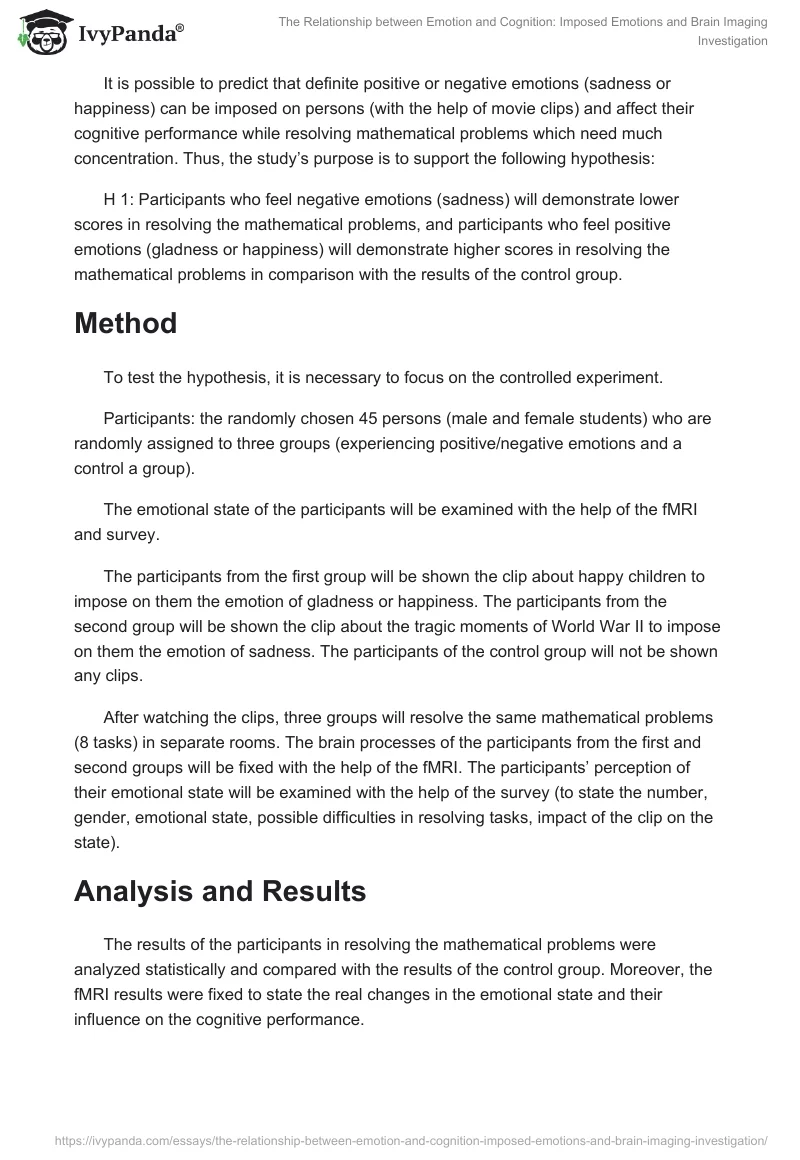Introduction
The direct interdependence between emotion and cognition is discussed by researchers as the stated phenomenon. Emotion affects attention, memory, and reasoning (Dolan, 2002).
The researchers study the effects of emotion on the person’s cognitive processes with the help of functional magnetic resonance imaging (fMRI), and there is the supported argument that emotion can affect cognition significantly because of stimulating the activities of the definite cognitive control and executive brain regions (Denkova et al., 2010). Furthermore, the changes in the cognitive performance depend on a variety of the personal psychological characteristics (Dolcos, Iordan, & Dolcos, 2011).
Although there are many studies which focus on the relationship between emotion and cognition, more research is necessary to state the direct relationship between the impact of negative and positive emotions on the cognitive performance.
The study’s objective is to examine the dependence of the cognitive performance on negative and positive emotions which are imposed on persons and to support the results with references not only to the words of participants but also to fMRI results to state the real emotions’ effects on the definite brain’s areas and cognition.
Purpose
People’s emotions affect their cognition and ability to resolve the tasks which need the great concentration as it is stated in the other researchers’ investigations (Denkova et al., 2010; Dolan, 2002; Dolcos, Iordan, & Dolcos, 2011).
It is possible to predict that definite positive or negative emotions (sadness or happiness) can be imposed on persons (with the help of movie clips) and affect their cognitive performance while resolving mathematical problems which need much concentration. Thus, the study’s purpose is to support the following hypothesis:
H 1: Participants who feel negative emotions (sadness) will demonstrate lower scores in resolving the mathematical problems, and participants who feel positive emotions (gladness or happiness) will demonstrate higher scores in resolving the mathematical problems in comparison with the results of the control group.
Method
To test the hypothesis, it is necessary to focus on the controlled experiment.
Participants: the randomly chosen 45 persons (male and female students) who are randomly assigned to three groups (experiencing positive/negative emotions and a control a group).
The emotional state of the participants will be examined with the help of the fMRI and survey.
The participants from the first group will be shown the clip about happy children to impose on them the emotion of gladness or happiness. The participants from the second group will be shown the clip about the tragic moments of World War II to impose on them the emotion of sadness. The participants of the control group will not be shown any clips.
After watching the clips, three groups will resolve the same mathematical problems (8 tasks) in separate rooms. The brain processes of the participants from the first and second groups will be fixed with the help of the fMRI. The participants’ perception of their emotional state will be examined with the help of the survey (to state the number, gender, emotional state, possible difficulties in resolving tasks, impact of the clip on the state).
Analysis and Results
The results of the participants in resolving the mathematical problems were analyzed statistically and compared with the results of the control group. Moreover, the fMRI results were fixed to state the real changes in the emotional state and their influence on the cognitive performance.
The difference of test scores was of interest that is why the ANOVA model was used to analyze the data basing on the 2×3 factorial design where the independent variables are the gender and experienced emotion while the dependent variable is the influenced test score. The test score of the control group was fixed to compare the results.
Table 1 states the connection between changes in the emotional state and changes in processes in the definite areas of the brain while resolving the mathematical problems.
Table 1. fMRI Results
Table 2 demonstrates the higher results in resolving the mathematical problems characteristic for the first group and lower results in resolving the mathematical problems typical for the second group in comparison with the results of the control group.
Table 2. Group’s Results
Table 3 is the ANOVA Summary Table to analyze the relationship between the gender, emotion, and test score of the participants depending on the combination of variables (ax, ay, az; bx, by, bz: a- male, b-female; x-happiness, y-sadness, z-neutral).
Table 3. The ANOVA Summary Table
Figure 1 demonstrates the results of the ANOVA regarding the test score which is influenced by emotion. The results are supported with the information presented in the survey. The participants from the second group stated that after watching the clip, it was rather difficult to concentrate on the mathematical problems. The changes in the emotional state and difficulties experienced are observed.
Figure 1. The Relationship between Gender, Emotion, and Test Score

Discussion
The hypothesis was supported with references to the study conducted. It is possible to state that definite emotions such as sadness and gladness or happiness can be imposed on the persons. Furthermore, negative and positive emotions can directly affect the persons’ cognitive performance.
There is the direct correlation between the experience of the negative and positive emotions and the ability to concentrate on resolving the mathematical problems. The changes in the processes in the definite areas of the brain support the opinion that emotions influence the cognitive processes significantly.
Moreover, there is the obvious difference in the impact of the positive and negative emotions of the ability to concentrate and resolve difficult tasks effectively. Thus, the imposed positive emotions affect the persons’ cognitive performance in a positive manner, increasing the results. However, the imposed negative emotions can make persons experience the additional difficulties while resolving the mathematical problems.
The practical significance of the study is in stating the direct dependence of cognition on emotion. Moreover, the role of imposed emotions is observed. It is possible to develop the further investigations, stating that the cognitive performance of the person can be changed with the help of the emotion imposed on the individual. Thus, it is possible to declare the positive impact of positive emotions on cognition.
The study is limited in relation to the number of emotions discussed as influential for affecting the persons’ cognitive processes. The further research can be conducted to expand the number of emotions examined and to add more variants to impose definite emotions on people without using movie clips.
References
Denkova, E., Wong, G., Dolcos, S., Sung, K., Wang, L., Coupland, N., & Dolcos, F. (2010). The impact of anxiety-inducing distraction on cognitive performance: a combined brain imaging and personality investigation. PLOS one, 5(11), 42-56.
Dolan, R. J. (2002). Emotion, cognition, and behavior. Science, 298(5596), 1191-1210.
Dolcos, F., Iordan, A. D., & Dolcos, S. (2011). Neural correlates of emotion-cognition interactions: A review of evidence from brain imaging investigations. Journal of Cognitive Psychology, 23(6), 669-694.


